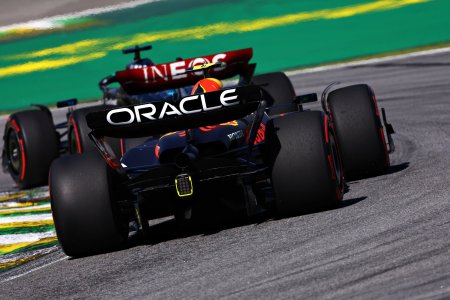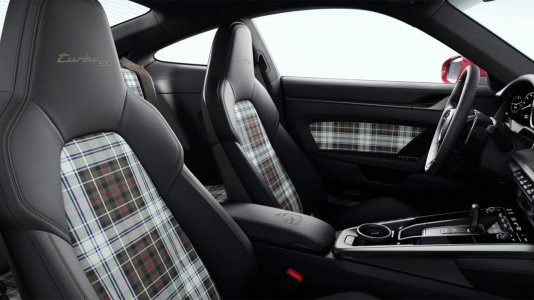The Lotus 23 saw great success at it's debut race at the Nürburgring, and so, still riding high from all the publicity, team Lotus entered a modified Lotus 23 for the 24h of Le Mans that year. A sister car ran by privateers, with the same modifications, was also entered. Here's the story of how they got banned:

With the sensational Nürburgring debut well publicised in the press, two 23s were entered at Le Mans in June 1962. One with a 742 cc (45.3 cu in) aluminium-block DOHC Coventry Climax FWMC with drivers Les Leston / Tony Shelly, and another with one litre Iron block pushrod Cosworth Mk.III with drivers Jim Clark / Trevor Taylor.
The 23s failed to pass the scrutineering on several technical grounds, including an insufficient windscreen height, fuel tank capacity being too large, turning circle too large, ground clearance too small, and the spare tyre requirement not met. Fitted with a makeshift tall wind screen, all but the spare tyre issue was rectified almost immediately.
The original 23 and the later 23B had 4 stud front and 6 stud rear wobbly-web wheels, and carried the narrower and lighter front wheel with its tyre mounted as the spare. (23C had wider 6 stud front and rear wheels.)

The French scrutineers argued the requirement to carry a spare tyre is for the purpose of changing a flat, which is not satisfied by the 23 in the case of a flat occurring on one of the rear tyres. So the Lotus factory had a 4 stud rear hubs drafted and machined over-night, and had a person carry them and flown to Le Mans the next day. After being presented with the 23s with 4 stud rears installed, the scrutineers rejected again on the grounds that the 6 stud configuration must have been a reflection of strength requirement in the original design, so the 4 stud configuration was deemed unsafe.
The scrutineers and the ACO did not change this position even after Mike Costin, the Lotus engineer on site, offered to go over structural analysis calculations showing the difference falls within the safety margin built in the design to accommodate more powerful 1,098 cc (67.0 cu in) Cosworth Mk.IV and 1,475 cc (90.0 cu in) Cosworth Mk.VII engines.

One of the two Lotus 23s with 4 stud rears, with Cosworth Mk.III 997 cc (60.8 cu in) engine, was sold off sans engine on the spot to the 1 litre class winning driver of the event, with a lease on the engine and support contract attached, on a strict condition imposed by Chapman to keep the 4 stud configuration for longer than one racing season. The French driver/buyer, Bernard Consten, not only obliged but won Clermont-Ferrand 6 Hours and 1000 km of Montlhery that year with this 23 without breaking the studs, the hub, or the wheel.
Team Lotus remained on the scene for the entire 1962 event supporting and winning the 1.3 litre GT class and the Index of Performance prize by a Lotus Elite driven by David Hobbs and Frank Gardner. ACO officials then made the situation worse in admitting a mistake, offering a financial compensation for the 23 entries after the race. With pro-Lotus motoring journalist Gérard Crombac (who reported the entire fiasco in a French publication, suggesting the Ferrari 246SP and 268SP had the same ground clearance issue, but were allowed to race unrectified after the Ferrari team threatened to withdraw the entire team) present as the interpreter in the meeting, Chapman suggested a figure which was too large for the officials to swallow. Upon being rejected, Chapman vowed "We will never race again at Le Mans!", a promise that Lotus kept until 1997, long after Chapman's death in 1982.


In the past month, I've decided to set up a Patreon page where I will upload more standalone liveries, while focusing on packs here on RD. Some liveries will be exclusively for paying members, but most uploads will be free. So drop a follow if you haven't already!
Pasta's Livery Warehouse
With the sensational Nürburgring debut well publicised in the press, two 23s were entered at Le Mans in June 1962. One with a 742 cc (45.3 cu in) aluminium-block DOHC Coventry Climax FWMC with drivers Les Leston / Tony Shelly, and another with one litre Iron block pushrod Cosworth Mk.III with drivers Jim Clark / Trevor Taylor.
The 23s failed to pass the scrutineering on several technical grounds, including an insufficient windscreen height, fuel tank capacity being too large, turning circle too large, ground clearance too small, and the spare tyre requirement not met. Fitted with a makeshift tall wind screen, all but the spare tyre issue was rectified almost immediately.
The original 23 and the later 23B had 4 stud front and 6 stud rear wobbly-web wheels, and carried the narrower and lighter front wheel with its tyre mounted as the spare. (23C had wider 6 stud front and rear wheels.)
The French scrutineers argued the requirement to carry a spare tyre is for the purpose of changing a flat, which is not satisfied by the 23 in the case of a flat occurring on one of the rear tyres. So the Lotus factory had a 4 stud rear hubs drafted and machined over-night, and had a person carry them and flown to Le Mans the next day. After being presented with the 23s with 4 stud rears installed, the scrutineers rejected again on the grounds that the 6 stud configuration must have been a reflection of strength requirement in the original design, so the 4 stud configuration was deemed unsafe.
The scrutineers and the ACO did not change this position even after Mike Costin, the Lotus engineer on site, offered to go over structural analysis calculations showing the difference falls within the safety margin built in the design to accommodate more powerful 1,098 cc (67.0 cu in) Cosworth Mk.IV and 1,475 cc (90.0 cu in) Cosworth Mk.VII engines.
One of the two Lotus 23s with 4 stud rears, with Cosworth Mk.III 997 cc (60.8 cu in) engine, was sold off sans engine on the spot to the 1 litre class winning driver of the event, with a lease on the engine and support contract attached, on a strict condition imposed by Chapman to keep the 4 stud configuration for longer than one racing season. The French driver/buyer, Bernard Consten, not only obliged but won Clermont-Ferrand 6 Hours and 1000 km of Montlhery that year with this 23 without breaking the studs, the hub, or the wheel.
Team Lotus remained on the scene for the entire 1962 event supporting and winning the 1.3 litre GT class and the Index of Performance prize by a Lotus Elite driven by David Hobbs and Frank Gardner. ACO officials then made the situation worse in admitting a mistake, offering a financial compensation for the 23 entries after the race. With pro-Lotus motoring journalist Gérard Crombac (who reported the entire fiasco in a French publication, suggesting the Ferrari 246SP and 268SP had the same ground clearance issue, but were allowed to race unrectified after the Ferrari team threatened to withdraw the entire team) present as the interpreter in the meeting, Chapman suggested a figure which was too large for the officials to swallow. Upon being rejected, Chapman vowed "We will never race again at Le Mans!", a promise that Lotus kept until 1997, long after Chapman's death in 1982.
In the past month, I've decided to set up a Patreon page where I will upload more standalone liveries, while focusing on packs here on RD. Some liveries will be exclusively for paying members, but most uploads will be free. So drop a follow if you haven't already!
Pasta's Livery Warehouse










